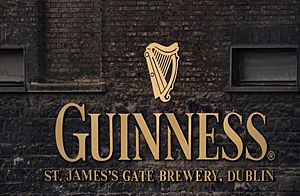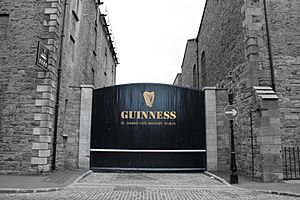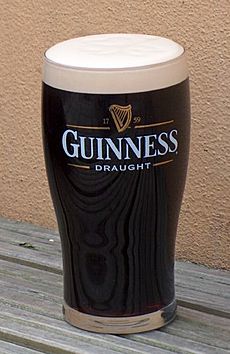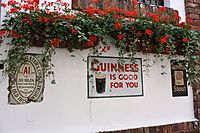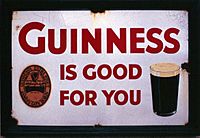Guinness facts for kids
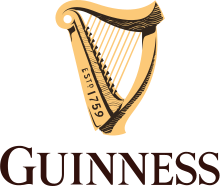 |
|
| Type | Dry stout (beer) |
|---|---|
| Manufacturer | Diageo |
| Country of origin | Ireland |
| Introduced | 1759 |
| Alcohol by volume | 4.2% |
| Colour | Black (sometimes described as very dark ruby-red) |
| Flavour | Dry |
Guinness (/ˈɡɪnəs/) is an Irish dry stout that originated in the brewery of Arthur Guinness at St. James's Gate, Dublin, Ireland, in 1759. It is one of the most successful alcohol brands worldwide, brewed in almost 50 countries, and available in over 120. Sales in 2011 amounted to 850,000,000 liters (190,000,000 imp gal; 220,000,000 U.S. gal). In spite of declining consumption since 2001, it is the best-selling alcoholic drink in Ireland where Guinness & Co. Brewery makes almost €2 billion worth of beer annually.
The Guinness Storehouse is a tourist attraction at St. James's Gate Brewery in Dublin, Ireland. Since opening in 2000, it has received over 20 million visitors.
Guinness's flavour derives from malted barley and roasted unmalted barley, a relatively modern development, not becoming part of the grist until the mid-20th century. For many years, a portion of aged brew was blended with freshly brewed beer to give a sharp lactic acid flavour. Although Guinness's palate still features a characteristic "tang", the company has refused to confirm whether this type of blending still occurs. The draught beer's thick, creamy head comes from mixing the beer with nitrogen and carbon dioxide.
The company moved its headquarters to London at the beginning of the Anglo-Irish trade war in 1932. In 1997, Guinness plc merged with Grand Metropolitan to form the multinational alcoholic-drinks producer Diageo plc, based in London.
Contents
History
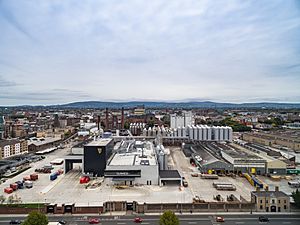
Arthur Guinness started brewing ales in 1759 at the St. James's Gate Brewery, Dublin. On 31 December 1759, he signed a 9,000 year lease at £45 per annum for the unused brewery. Ten years later, on 19 May 1769, Guinness first exported his ale: he shipped six-and-a-half barrels to Great Britain.
Arthur Guinness started selling the dark beer porter in 1778. The first Guinness beers to use the term were Single Stout and Double Stout in the 1840s. Throughout the bulk of its history, Guinness produced only three variations of a single beer type: porter or single stout, double or extra and foreign stout for export. "Stout" originally referred to a beer's strength, but eventually shifted meaning toward body and colour. Porter was also referred to as "plain", as mentioned in the famous refrain of Flann O'Brien's poem "The Workman's Friend": "A pint of plain is your only man."
Already one of the top-three British and Irish brewers, Guinness's sales soared from 350,000 barrels in 1868 to 779,000 barrels in 1876. In October 1886, Guinness became a public company and was averaging sales of 1.138 million barrels a year. This was despite the brewery's refusal to either advertise or offer its beer at a discount. Even though Guinness owned no public houses, the company was valued at £6 million and shares were 20 times oversubscribed, with share prices rising to a 60 per cent premium on the first day of trading.
The breweries pioneered several quality control efforts. The brewery hired the statistician William Sealy Gosset in 1899, who achieved lasting fame under the pseudonym "Student" for techniques developed for Guinness, particularly Student's t-distribution and the even more commonly known Student's t-test.
By 1900 the brewery was operating unparalleled welfare schemes for its 5,000 employees. By 1907 the welfare schemes were costing the brewery £40,000 a year, which was one-fifth of the total wages bill. The improvements were suggested and supervised by Sir John Lumsden. By 1914, Guinness was producing 2.652 million barrels of beer a year, which was more than double that of its nearest competitor Bass, and was supplying more than 10 per cent of the total UK beer market.
When World War I broke out in 1914, employees at Guinness St. James Brewery were encouraged to join the British forces. Over 800 employees served in the war. This was made possible due to a number of measures put in place by Guinness: soldiers' families were paid half wages, and jobs were guaranteed upon their return. Of the 800 employees who fought, 103 did not return.
During World War II, the demand for Guinness among the British was one of the main reasons why the UK lifted commerce restrictions imposed in 1941 to force Ireland into supporting the Allied Powers.
Before 1939, if a Guinness brewer wished to marry a Catholic, his resignation was requested. According to Thomas Molloy, writing in the Irish Independent, "It had no qualms about selling drink to Catholics but it did everything it could to avoid employing them until the 1960s."
Guinness thought they brewed their last porter in 1973. In the 1970s, following declining sales, the decision was taken to make Guinness Extra Stout more "drinkable". The gravity was subsequently reduced, and the brand was relaunched in 1981. Pale malt was used for the first time, and isomerised hop extract began to be used. In 2014, two new porters were introduced: West Indies Porter and Dublin Porter.
Guinness acquired The Distillers Company in 1986. This led to a scandal and criminal trial concerning the artificial inflation of the Guinness share price during the takeover bid engineered by the chairman, Ernest Saunders. A subsequent £5.2 million success fee paid to an American lawyer and Guinness director, Tom Ward, was the subject of the case Guinness plc v Saunders, in which the House of Lords declared that the payment had been invalid.
In the 1980s, as the IRA's bombing campaign spread to London and the rest of Britain, Guinness considered scrapping the harp as its logo.
Composition
Guinness stout is made from water, barley, roast malt extract, hops, and brewer's yeast. A portion of the barley is roasted to give Guinness its dark colour and characteristic taste. It is pasteurised and filtered.
Until the late 1950s, Guinness was still racked into wooden casks. In the late 1950s and early 1960s, Guinness ceased brewing cask-conditioned beers and developed a keg brewing system with aluminium kegs replacing the wooden casks; these were nicknamed "iron lungs". Until 2016 the production of Guinness, as with many beers, involved the use of isinglass made from fish. Isinglass was used as a fining agent for settling out suspended matter in the vat. The isinglass was retained in the floor of the vat but it was possible that minute quantities might be carried over into the beer. Diageo announced in February 2018 that the use of isinglass in draught Guinness was to be discontinued and an alternative clarification agent would be used instead. This has made draught Guinness acceptable to vegans and vegetarians.
Present day Guinness
Arguably its biggest change to date, in 1959 Guinness began using nitrogen, which changed the fundamental texture and flavour of the Guinness of the past as nitrogen bubbles are much smaller than CO2, giving a "creamier" and "smoother" consistency over a sharper and traditional CO2 taste. This step was taken after Michael Ash—a mathematician turned brewer—discovered the mechanism to make this possible.
Nitrogen is less soluble than carbon dioxide, which allows the beer to be put under high pressure without making it fizzy. High pressure of the dissolved gas is required to enable very small bubbles to be formed by forcing the draught beer through fine holes in a plate in the tap, which causes the characteristic "surge" (the widget in cans and bottles achieves the same effect). This "widget" is a small plastic ball containing the nitrogen. The perceived smoothness of draught Guinness is due to its low level of carbon dioxide and the creaminess of the head caused by the very fine bubbles that arise from the use of nitrogen and the dispensing method described above. Foreign Extra Stout contains more carbon dioxide, causing a more acidic taste.
Contemporary Guinness Draught and Extra Stout are weaker than they were in the 19th century, when they had an original gravity of over 1.070. Foreign Extra Stout and Special Export Stout, with ABV of 7.5% and 9% respectively, are perhaps closest to the original in character.
Although Guinness is black, and is referred to as "the black stuff", it is also "officially" referred to as a very dark shade of ruby.
The most recent change in alcohol content from the Import Stout to the Extra Stout was due to a change in distribution through North American market. Consumer complaints influenced subsequent distribution and bottle changes.
Sinking bubbles
When Guinness is poured, the gas bubbles appear to travel downwards in the glass. The effect is attributed to drag; bubbles that touch the walls of a glass are slowed in their travel upwards. Bubbles in the centre of the glass are, however, free to rise to the surface, and thus form a rising column of bubbles. The rising bubbles create a current by the entrainment of the surrounding fluid. As beer rises in the centre, the beer near the outside of the glass falls. This downward flow pushes the bubbles near the glass towards the bottom. Although the effect occurs in any liquid, it is particularly noticeable in any dark nitrogen stout, as the drink combines dark-coloured liquid and light-coloured bubbles.
A study published in 2012 revealed that the effect is due to the particular shape of the glass coupled with the small bubble size found in stout beers. If the vessel widens with height, then bubbles will sink along the walls – this is the case for the standard pint glass. Conversely, in an anti-pint (i.e. if the vessel narrows with height) bubbles will rise along the walls.
Culinary uses
Guinness is frequently used as an ingredient in recipes, often to add a seemingly authentic Irish element to the menus of Irish-themed pubs in the United States, where it is stirred into everything from french toast to beef stew.
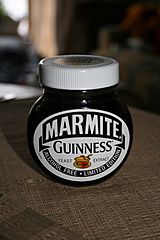
A popular, authentic, Irish course featuring Guinness is the "Guinness and Steak Pie". The recipe includes many common Irish herbs, as well as beef brisket, cheeses, and a can of Guinness.
Advertising
The Guinness harp motif is modelled on the Trinity College harp. It was adopted in 1862 by the incumbent proprietor, Benjamin Lee Guinness. Harps have been a symbol of Ireland at least since the reign of Henry VIII. Guinness registered their harp as a trademark shortly after the passing of the Trade Marks Registration Act of 1875. It faces right instead of left, and so can be distinguished from the Irish coat of arms.
Since the 1930s, in the face of falling sales, Guinness has had a long history of marketing campaigns, from television advertisements to beer mats and posters. Before then, Guinness had almost no advertising, instead allowing word of mouth to sell the product.
The most notable and recognisable series of advertisements was created by S. H. Benson's advertising, primarily drawn by the artist John Gilroy, in the 1930s and 1940s. Benson created posters that included phrases such as "Guinness for Strength", "Lovely Day for a Guinness", "Guinness Makes You Strong", "My Goodness My Guinness" (or, alternatively, "My Goodness, My Christmas, It's Guinness!"), and most famously, "Guinness Is Good for You". The posters featured Gilroy's distinctive artwork and more often than not featured animals such as a kangaroo, ostrich, seal, lion and notably a toucan, which has become as much a symbol of Guinness as the harp. (An advertisement from the 1940s ran with the following jingle: "Toucans in their nests agree/Guinness is good for you/Try some today and see/What one or toucan do.") Dorothy L. Sayers and R. A. Bevan copywriters at Benson's also worked on the campaign; a biography of Sayers notes that she created a sketch of the toucan and wrote several of the adverts in question. Guinness advertising paraphernalia, notably the pastiche booklets illustrated by Ronald Ferns, attract high prices on the collectable market.
Many of the best known Guinness television advertisements of the 1970s and 1980s were created by British director, Len Fulford.
Guinness won the 2001 Clio Award as the Advertiser of the Year, citing the work of five separate ad agencies around the world.
In 2002, Guinness applied the Michael Power formula to Asia with the character Adam King. The campaign featured such tag lines as: "Everyday someone, somewhere achieves something new. Sometimes on a grand, dramatic scale. Sometimes on a more personal scale." As of 2004, Guinness ranked among the top three beer labels in Singapore and Malaysia, with a 20 per cent market share across Southeast Asia. Malaysia was the brand's third-largest market in the region and the sixth largest market worldwide.
In 2003, the Guinness TV campaign featuring Tom Crean won the gold Shark Award at the International Advertising Festival of Ireland, while in 2005 their Irish Christmas campaign won a silver Shark. This TV ad has been run every Christmas since its debut in December 2004 and features pictures of snow falling in places around Ireland finishing at St. James's Gate Brewery with the line: "Even at the home of the black stuff they dream of a white one".
The UK commercial "noitulovE", first broadcast in October 2005, was one of the most-awarded commercials worldwide in 2006. In 2006, Diageo, owner of the Guinness brand, replaced the Michael Power campaign with the "Guinness Greatness" campaign, which they claim emphasises the "drop of greatness" in everyone, in contrast to the high-tension heroics of the Power character.
Guinness's 2007 advertisement, directed by Nicolai Fuglsig and filmed in Argentina, is entitled "Tipping Point". It involves a large-scale domino chain reaction and, with a budget of £10 million, was the most expensive advertisement by the company at that point.
The 2000s also saw a series of television advertisements, entitled Brilliant! in which two crudely animated Guinness brewmasters would discuss the beer, particularly the ability to drink it straight from the bottle. The two would almost always react to their discoveries with the catchphrase "Brilliant!", hence the campaign's title.
In 2009, the To Arthur advertisement, which started with two friends realising the company's long history, hail each other by lifting up their glasses and saying: "to Arthur!". The hailing slowing spread throughout the bar to the streets outside, and finally around the world. The advertisement ends with the voiceover: "Join the worldwide celebration, of a man named Arthur".
This gave rise to the event now known as Arthur's Day. "Arthur's Day is a series of events and celebrations taking place around the world to celebrate the life and legacy of Arthur Guinness and the much-loved Guinness beer which Arthur brought to the world."
Following the COVID-19 pandemic and pub closures, Guinness produced a "Looks Like Guinness" advert in anticipation of pubs reopening in 2021.
Worldwide sales
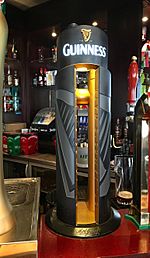
In 2006, sales of Guinness in Ireland and the United Kingdom declined 7 percent. Despite this, Guinness still accounts for more than a quarter of all beer sold in Ireland. By 2015, sales were on the rise in Ireland but flat globally.
Guinness began retailing in India in 2007.
Guinness has a significant share of the African beer market, where it has been sold since 1827. About 40 percent of worldwide total Guinness volume is brewed and sold in Africa, with Foreign Extra Stout the most popular variant. Three of the five Guinness-owned breweries worldwide are located in Africa.
The beer is brewed under licence internationally in several countries, including Nigeria, the Bahamas, Canada, Cameroon, Kenya, Uganda, South Korea, Namibia, and Indonesia.
In 2017, Guinness teamed up with AB InBev to distribute Guinness in mainland China.
The United Kingdom is the only sovereign state to consume more Guinness than Ireland. In 2023, a pub in London claimed to offer the cheapest pint of Guinness in the UK, at £2. The third-largest Guinness drinking nation is Nigeria, followed by the USA; the United States consumed more than 950 million hectoliters (2.1×1010 imp gal; 2.5×1010 U.S. gal) of Guinness in 2010.
Merchandising
The Guinness Storehouse at St. James's Gate Brewery in Dublin is the most popular tourist attraction in Ireland (attracting over 1.7 million visitors in 2019) where a self-guided tour includes an account of the ingredients used to make the stout and a description of how it is made. Visitors can sample the smells of each Guinness ingredient in the Tasting Rooms, which are coloured with a unique lighting design that emits Guinness's gold and black branding.
The Guinness Book of Records started as a Guinness marketing giveaway, based on an idea of its then Managing Director, Sir Hugh Beaver. Its holding company, Guinness World Records Ltd, was owned by Guinness plc, subsequently Diageo, until 2001.


